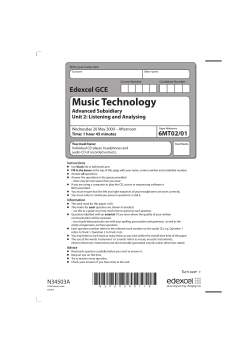
Document 242237
Article Type : Knowledge Library Article Article Title : BPM, What is it? Author : Kem Tissiman Published to : Rethink Online Knowledge Library Enquiries to : Rob Steyn (rob@rethink.co.za) BPM – What is it? The acronym ‘BPM’ is certainly enjoying a high profile and level of recognition in the business and IT space, mainly due to the workflow (now BPM) vendors who adopted the acronym some 5 years ago to describe the next generation of their systems. However, there are a number of other communities that also make use of this acronym for their software offerings, thus significant confusion exists within the user community as to what ‘BPM’ stands for. For example if the article that appeared in IT Web in July under the headline ‘Demand grows for BPM software’ is analysed, two different BPM software vendors were mentioned. The first offers the workflow type BPM system and the other a financial reporting tool. These are very different solutions, yet lumped have been together because both go under the acronym ‘BPM’. If one examines what is being called BPM, there are four distinct approaches that have emerged that all use this same acronym. The first of the popular uses of ‘BPM’ is where it stands for Business Process Management and is seen as a holistic management approach encompassing a set of business practices and management disciplines that ensure that business processes are constantly monitored and changed over time to ensure that they are both optimal and aligned with corporate strategy. This is the BPM approach more recently espoused by Gartner. The key requirements include: • establishing a full and clear knowledge of all processes, so that they are clearly understood and can be effectively improved as and when required; • establishing a process driven organisation via re-engineering to create end to end processes, with process owners being responsible for monitoring process performance and driving ongoing improvement initiatives; and, KL001-A Kem Tissiman Page 1 of 4 • establishing the necessary practices to ensure ongoing process performance monitoring and improvement. The implementation of automation suites (BPMS or Workflow systems) may play a role in this approach to BPM but is not core to it. What is vital to this BPM approach is establishing and entrenching the necessary management practices and disciplines in order to ensure a culture of continuous process monitoring and improvement. The second popular use of ‘BPM’ is where it also stands for Business Process Management, but has been adopted by the workflow community to describe the next generation of their software. Together with this they promote a strategy where organisations implement BPM systems together with SOA (Services Oriented Architecture) to build flexible automated processes, and then via integrated reporting and simulation tools, monitor and adjust these processes in real time to ensure that they are both optimal and aligned with corporate strategy. The key difference between this and the first approach is that this community sees a BPM strategy being about the implementation of a BPM system, as opposed to BPM being a company wide management strategy that may include BPM systems as one of many enablers they may use. The BPM systems mentioned here typically include workflow, rules engines, system integration, reporting, process modeling and simulation capabilities, all within one integrated system. The implementation that is typically followed with this view of BPM is that processes are mapped in a workflow notation and then improved via simulation. Being in one system they can then be deployed ‘as is’ for production execution after being optimised, without any further development effort required. Using integrated monitoring and reporting capability the performance of processes is monitored against set KPI’s. Where improvements are identified these can be modelled and tested via simulation, and once accepted, deployed on the fly. The term commonly used to describe this cycle is round-trip re-engineering, and although only a few BPM systems currently include the full set of capabilities, it is what they are typically striving towards. Some of the well known vendors that play in this space are FileNet, Fuego, Global 360, Tibco and Ultimus. Whereas they all claim similar functionality, the level of cost and capability varies enormously amongst the different vendors. A third use for the acronym ‘BPM’ is where process mapping and documentation tools are also referred to as Business Process Management (BPM) tools or systems. This is based on the notion that in order to manage an organisation’s processes over time they first need to be accurately documented in their current form. With this as a starting point processes can then be properly analysed and improved over time. Because process information is always current and visible, ongoing analysis and improvement is easy to sustain. The opposite is having to document the ‘as is’ whenever improvement projects are embarked upon. These tools or systems, which are distinctly different from the BPMS automation suites, are a key requirement for the management of business processes across a company. There are a multitude of KL001-A Kem Tissiman Page 2 of 4 process documentation and mapping tools available that are being termed BPM tools, from low end drawing tools to high end tools that are rich in the functionality required to effectively manage very large volumes of processes and the associated documentation. Some of these higher end tools are ARRIS, Casewise, Control-ES, QPR and System Architect. The fourth major use of the acronym BPM is by the BI community, where it is used as the abbreviation for Business Performance Management, (also termed CPM or Corporate Performance Management), and seen as the next generation of BI. In this case BPM relates to the use of financial and non financial metrics or key performance indicators to present the current state of a business, based on which a course of action to improve on the situation can be devised as and where required. The focus of this BPM approach is at a higher financial data reporting level and aims to implement improved processes that ensure: • better confidence in financial data via better data quality, • improved productivity of the financial staff, and, • lower costs of compliance. This version of BPM software focuses on financial reporting and the associated processes and is very different to what the workflow-orientated BPM(S) vendors offer. In terms of IT systems in this space, Balance Scorecard, BI, Data Warehouse, DSS, EIS, MIS and OLAP, tools all play a role. Vendors typically include Business Objects, Cognos, Hyperion, Longview, Prophix Software, Saksoft, SapienceBI and SAS. With four different meanings associated with the term BPM, what are the key issues to be aware of? • Organisations that are considering a BPM strategy should ensure that they have a clear understanding what Business Process Management means and the different types of BPM software offerings available to support such a strategy. Only then should they devise a BPM strategy, independent of any specific software tool, following which the appropriate software tools can be deployed as and where required to enable an implementation of the strategy. • Organisations should be aware that when driving BPM via the implementation of a BPM system, they will be limited to ‘doing’ BPM only with those processes that are automated. In a large organisation this could take a long time, thus slowing the achievement of the target benefits. In addition, BPM benefits will never be achieved with the processes that are not automated. Alternatively, the Process Mapping driven BPM approach enables BPM to be focused across the entire organisation such that all processes are included. Time frames are typically shorter as the more complex process automation is KL001-A Kem Tissiman Page 3 of 4 not the core focus. Once the BPM strategy is implemented and working, process automation can be undertaken selectively, as and where appropriate. • An organisation would do well to include all four of the above mentioned BPM approaches in its corporate BPM strategy, i.e. embark on a broad BPM strategy based on establishing management practices that ensure that processes are assessed and improved on an ongoing basis. To support this, make use of a high level process documentation tool to in order to document the processes in their current state, and to provide a foundation for the future process assessment and improvement work. Then undertake process automation as and where it will unlock further benefits, and lastly, implement a sound BI/BPM tool to provide information on how processes are performing. For further information, please contact Kem Tissiman at tel. +27 82 413 6044; fax +27 11 285 0054; email kem@rethink.co.za Editors note Rethink Management Consulting is an independent company that provides a set of integrated services that are aimed at helping organisations with their ongoing business improvement and development initiatives. Rethink works closely with its clients to help identify and design business change initiatives, as well as with the management and execution thereof. Rethink’s end objective is to help its clients achieve improvements in the areas of financial performance and customer service. The core services offered are process engineering, production management/productivity improvement and project management. Prepared by – Paul Booth Global Research Partners Tel : +27 82-568-1179 Fax : +27 11 463-0448 E-mail : pabooth@cis.co.za On behalf of – Kem Tissiman Rethink Management Consulting © Rethink Management Consulting (Pty) Ltd. KL001-A Kem Tissiman Page 4 of 4
© Copyright 2025















